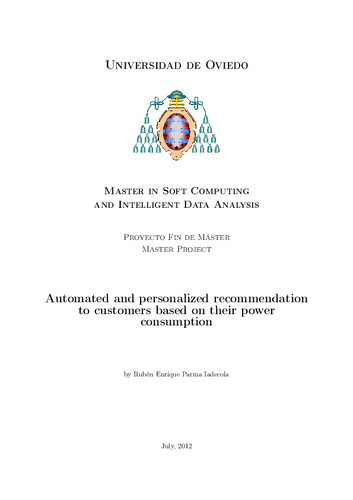Automated and personalized recommendation to customers based on their power consumption
Autor(es) y otros:
Director(es):
Palabra(s) clave:
Computational Theory of Perceptions
Granular Linguistic Model of Phenomena
CPA7L
Fuzzy Logic
Fecha de publicación:
Serie:
Máster Universitario en Soft Computing y Análisis Inteligente de Datos
Resumen:
In the companies of these days every customer plays a very important role, and must be integrated in the business model. Techniques like customer relationship management (CRM), helps to maintain good relations with customers. But for those big companies with hundreds of clients, it can be very difficult to have a personalized contact with each customer. So, if an autonomous virtual agent can interact with each customer and make suggestions about their behaviour, it would be a great improvement on getting a better customer relationship. However the way this it interacts with the customer should be as natural as possible to make him feel as it is talking with a real person that understand its situation. The aim of this project is to contribute to define a methodology and architecture to develop computational applications for generating linguistic descriptions of data. The methodology proposed is a mixture of different techniques from researches made at the Unit of Computing with Perceptions of the European Centre for Soft Computing. The Granular Linguistic Model of Phenomena (GLMP), provides a linguistic description of the current situation of the customer that is easy to understand. This is much better than present either a table with some values or graphics that shows a quantitative description of the customer situation. Additionally, to gain empathy with the customer, the autonomous virtual agent should show some emotional behaviour. These emotions came from the Affective Computing, and can be shown on two forms: incorporating emotions to the phrases that describes the situation and the suggestions; and by a visual representation of its facial expressions. Finally, to put all these elements together, the CPA7L model was used, as it encloses all the relevant aspects that need to be taken into account to tackle the interaction needed between the virtual agent and the customer, and provides a methodology to follow in the path for its design.
In the companies of these days every customer plays a very important role, and must be integrated in the business model. Techniques like customer relationship management (CRM), helps to maintain good relations with customers. But for those big companies with hundreds of clients, it can be very difficult to have a personalized contact with each customer. So, if an autonomous virtual agent can interact with each customer and make suggestions about their behaviour, it would be a great improvement on getting a better customer relationship. However the way this it interacts with the customer should be as natural as possible to make him feel as it is talking with a real person that understand its situation. The aim of this project is to contribute to define a methodology and architecture to develop computational applications for generating linguistic descriptions of data. The methodology proposed is a mixture of different techniques from researches made at the Unit of Computing with Perceptions of the European Centre for Soft Computing. The Granular Linguistic Model of Phenomena (GLMP), provides a linguistic description of the current situation of the customer that is easy to understand. This is much better than present either a table with some values or graphics that shows a quantitative description of the customer situation. Additionally, to gain empathy with the customer, the autonomous virtual agent should show some emotional behaviour. These emotions came from the Affective Computing, and can be shown on two forms: incorporating emotions to the phrases that describes the situation and the suggestions; and by a visual representation of its facial expressions. Finally, to put all these elements together, the CPA7L model was used, as it encloses all the relevant aspects that need to be taken into account to tackle the interaction needed between the virtual agent and the customer, and provides a methodology to follow in the path for its design.
Patrocinado por:
European Centre for Soft Computing Universidad de Oviedo
Colecciones
- Trabajos Fin de Máster [5283]
Ficheros en el ítem





